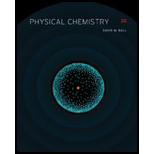
List the sets of conditions that allow
Interpretation:
The sets of conditions that allow
Concept introduction:
The spontaneous process can be defined as the process in which the free energy is released and the system moves to an energy state which is thermodynamically more stable.
Answer to Problem 4.1E
The spontaneity condition in terms of entropy is given at the constant internal energy and constant volume by the expression,
At constant volume and constant entropy, the condition for spontaneity is given in terms of internal energy as,
At constant pressure and entropy, the condition for spontaneity is given in terms of enthalpy as,
Explanation of Solution
The derivation of the spontaneity condition
Thus, according to the first law of thermodynamics
Thus,
The infinitesimal change in entropy is given by the expression,
According to the Clausius theorem, the entropy change is given by the expression,
This expression can be rewritten using the
At constant volume and constant entropy, the condition for spontaneity is given in terms of internal energy as,
For enthalpy the expression,
At constant pressure and entropy, the condition for spontaneity is given in terms of enthalpy as,
The spontaneity condition in terms of entropy is given at the constant internal energy and constant volume by the expression,
At constant volume and constant entropy, the condition for spontaneity is given in terms of internal energy as,
At constant pressure and entropy, the condition for spontaneity is given in terms of enthalpy as,
Want to see more full solutions like this?
Chapter 4 Solutions
Physical Chemistry
- Help with annotating the labeled peaks in the 'H NMR (solvent CDCls) spectra and 'H NMR (solvent Acetone-D6) spectra Also help with Calculating the keto-enol tautomerization Ka constant for the product in both solvents.Two solvents and two different Kaarrow_forwardDraw a Haworth projection of a common cyclic form of this monosaccharide CH₂OH HO H HO H H OH CH₂OHarrow_forwardCan you explain how I get these here and show the steps plz?arrow_forward
- Give the IUPAC name for this compound Hydrocarbon Condensed Formulas Hint C2H5 CH2CH3 expand that in all the formula Part A: (CH3)2CHCH(C2H5)CH2CH2CH3 Give the IUPAC name for this compound. Part B: CH2=C(C2H5)CH2CH2CH3 Give the IUPAC name for this compound. Part C: (CH3)2C=CHC(C2H5)=CH2 Give the IUPAC name for this compound. Part D: CH3C=CCH(C2H5)2 Give the IUPAC name for this compound. Part E: (CH3)3CC=CCH2CH=C(CH3)2arrow_forwardSelect/ Match the correct letter from the image below for the IUPAC names given below: A B C D 3 E F G H K L Part 1. 4-methylheptane For example.mmmm Answer Letter H _for part 1 Part 2. 2,4-dimethylhexane Part 3. 2,3-dimethylpentane Part 4. 2,2-dimethylhexane Part 5. 2-ethyl-1,1,3,3-tetramethylcyclopentane Part 6. 3-ethyl-2-methylpentanearrow_forwardCan u show the process as to how to get these?arrow_forward
- Sketch the expected 'H NMR spectra for the following compound. Label all of the H's in the structure and the corresponding signal for the spectra you sketch. Make sure you include the integration value and the splitting pattern for each signal Indicate how many signals you would expect in the 13C NMRarrow_forwardUse IUPAC naming rules to name the following hydrocarbon compounds: CH2-CH3 | a) CH-CH-CH2-CH-CH-CH3 b) | CH2 CH3 | CH3 CH3 \ / C=C H 1 H CH2-CH3 c) d) CH=C-CH3 e) CH3-CH2-CH2-CH=CH-CH3 f) CH2=CH-CH2-CH=CH-CH3 g) CH3-CH2-C = C-CH2-CH3 h)arrow_forwardQ5 Name the following : a. b. C. d. e.arrow_forward
 Physical ChemistryChemistryISBN:9781133958437Author:Ball, David W. (david Warren), BAER, TomasPublisher:Wadsworth Cengage Learning,
Physical ChemistryChemistryISBN:9781133958437Author:Ball, David W. (david Warren), BAER, TomasPublisher:Wadsworth Cengage Learning, Chemistry: The Molecular ScienceChemistryISBN:9781285199047Author:John W. Moore, Conrad L. StanitskiPublisher:Cengage Learning
Chemistry: The Molecular ScienceChemistryISBN:9781285199047Author:John W. Moore, Conrad L. StanitskiPublisher:Cengage Learning

